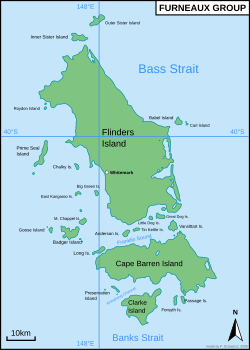
Franklin Sound is a narrow waterway between the two largest islands, Flinders Island and Cape Barren Island in the Furneaux Group, at the southeastern end of Bass Strait, between Victoria and Tasmania, Australia. [1]

Franklin Sound is a narrow waterway between the two largest islands, Flinders Island and Cape Barren Island in the Furneaux Group, at the southeastern end of Bass Strait, between Victoria and Tasmania, Australia. [1]
Named after British explorer and Lieutenant-Governor of Van Diemen's Land (1836–1843), Sir John Franklin (1786–1847). [2]
Numerous sandbanks and small islands obstruct the sound and the tidal stream runs at 2 to 3 knots. [1]
FRANKLIN SOUND was named by Captain Stokes after Sir John Franklin, a distinguished naval officer and explorer, who became Lieutenant-Governor of Tasmania in 1837.
40°17.5′S148°12.5′E / 40.2917°S 148.2083°E